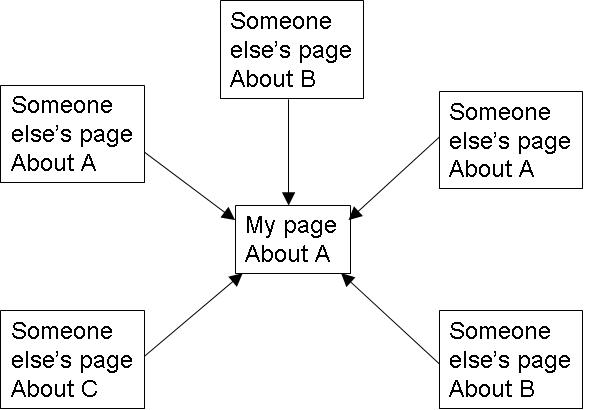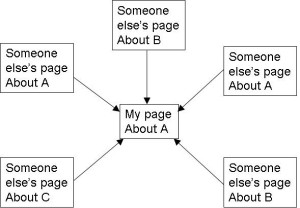Some SEO basics

Every time I write about SEO it amazes me that I’ve written so little about it in the past. Don’t believe me? When I talked about how to measure your seo effort back in March I said it then. Admittedly I didn’t say it last time I blogged about Bing doing Yahoo!’s search, but that is beside the point. In fact, whilst I’m on it – I always call it Yahoo! – but should it have the exclamation mark on the end or is that me just going over the top on the brand? Who knows. Anyway, I’ve been doing some explaining today about SEO to a group of people, so I thought I’d post what I was talking about on here. Really this is SEO basics – what you should do to make your site more search engine friendly.
This is a simplistic model of how search engines work. The search engine has a set of ‘spiders‘, which spider around the web. If you’ll excuse the pun. Essentially all it is a robot that looks at webpages, it scans the text on the website and the links (along with their anchor text – that’s the text of the link). It then takes the links on the page and scans those pages too. Anything that the first page was about that the second page is also about will cause the search engine to say that the second page has had a vote of confidence from the first page and it will put it in its search engine results page (SERPS) for the particular subject A was about.
Now extend that across the entire web for every single search phrase, every single link and every single page. Yep that’s a behemoth.
1. The Technical stuff on your page
So what does that mean we have to do? Firstly we need to tell the search engines what our pages are about. That way when someone else links to us from a page of similar subject, the search engines knows it is about the same subject. Take the diagram about – we have to tell the search engines our page is about A otherwise the search engines won’t know that those votes from other websites about A are relevant to our page.
We do this in a couple of ways. Firstly we have a Title of our page which has a couple of things in it. Mine looks a bit like this:
When can I stop?: Some SEO Basics – a blog by Alec Cochrane
This tells Google that this page is about SEO and it also tells it about the blog itself (although this is really because I have a generic title across all my pages, really you should have a bit more of a bespoke one for individual pages or blog posts in my case). This title appears in a couple of places – it’s up there in the little blue bar. It also appears as your link in your SERPs – so you should make sure that it is very descriptive and encourages people to click on the link.
The next thing to think about are your meta keywords. These are things that you can put in your page to describe what the page is about. They never appear on the page itself, you can’t see it, but when Google’s spiders come along they’ll see it and they’ll let it know what the pages are about. My page doesn’t have any, but if you right click on a page normally and view the source of a page, you should see something at the top that says meta name=”keyword” and then the content of the tag.
The next thing to think about is the meta description. This is the bit that appears in SERPS underneath your link. It should describe your site and encourage people to click on the link above. It doesn’t have to appear on your site either, but it should be in there.
Header tags are the next thing to think about and these come in more than one option. The first thing you should think about is your H1 tag. This is something physically on your page. It tells your users that this is the title of your page. You can also have H2 and H3 tags for hierarchical importance of text on the page.
2. The Technical stuff off your page
The next thing you should think about doing is making sure the search engines know about you. Usually this is simple – you get some links in and the spiders follow the links and find your pages. But it isn’t as simple as that. You may have a bunch of pages on your site that don’t have any links from outside sources, so you should make sure that they have links from within your site.
The easiest way of doing this is to create sitemaps. You’ll see links to them on the home page of most sites – usually in the left hand navigation. You just need a link on the page to a section with links to all the pages in it. It gives the search engines an easy way of finding all your content. For blogs we get around this problem by setting up tags on the pages – like those ones on the left hand side of my page.
The next thing you have to think about is that your links that are pointing towards page. But pages can quite frequently have many url. Search engines tend to think in urls and not in pages. Whilst they can sometimes tell that two urls are the same page, this isn’t always the case. This means you either need to do one of two things:
- Make sure that each page only has one url
- Any times when you can’t make sure that each page only has one url, make sure that your pages have identical content
If you do end up with more than one url for the same page the search engines will generally try and group the urls into one. If however the search engine thinks they are significantly enough different, then it may list them as two pages. This means that if you have a 3 links into one url and 2 links into another url both for the same page, then the search engines may list your two pages in the SERPs lower than another websites url that has say 4 links coming into it. This is the so called ‘duplicate content penalty‘.
3. Inbound links
Well I’ve already pointed this out before. It was that nice diagram at the top of the page. Every link into you’re site from another one is a vote for your page. But it is all the subject of the page linking to your page and the anchor text that it links to you with.
How do you affect other people’s sites? Not very easily, but there is no reason why you can’t aim to try. This revolves around press releases, commenting on blog posts, etc, etc. Think of reasons why you’d link from your site to someone elses. Then try and do that in reverse.
There – that was easy wasn’t it. Now if you just knew which phrases you wanted to be ranking for in the first place this whole thing would be easy.


Great post Alec – loving the puns as always.
I’ve found that the best keyword research tools to start off with are the free Google keyword research tool which offers two searching modes, and Google Insights (the rising searches section can be v useful).
Title,headings and meta keywords are must to make page search engine friendly.
Whilst technically I agree that you need to make sure you have your title, headings, meta keywords, etc set up to work, they are only the basics.
You need to make sure that you have the keywords that people are going to search for in there and that they then convert into value for you. See my post on measuring your SEO for this.